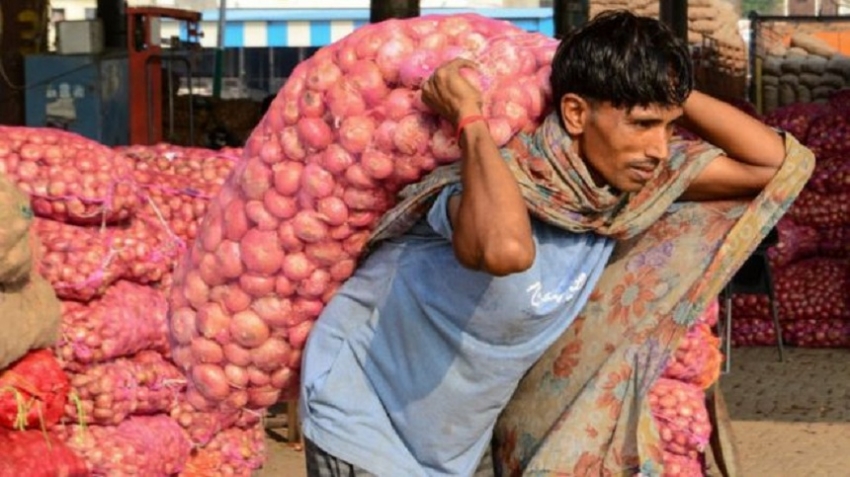The onion is India's most "political" vegetable Onion prices have yet again dominated the headlines in India over the past week. BBC Marathi's Janhavee Moole explains what makes this sweet and pungent vegetable so political.The onion - ubiquitous in Indian cooking - is widely seen as the poor man's vegetable.But it also has the power to tempt thieves, destroy livelihoods and - with its fluctuating price a measure of inflation - end the careers of some of India's most powerful politicians.With that in mind, it's perhaps unsurprising those politicians might be feeling a little concerned this week.
Onion prices had been on the rise in India since August, when 25 rupees ($0.35; £0.29) would have got you a kilo. At the start of October, that price was 80 rupees ($1.13; £0.91).Fearing a backlash, the Bharatiya Janata Party (BJP)-led government banned onion exports, hoping it would bring down the domestic price. And it did.Onion prices peaked by the end of September A kilo was selling for less than 30 rupees on Thursday at Lasalgaon, Asia's largest onion wholesale market, located in the western state of Maharashtra.
However, not everyone is happy.While high prices had angered consumers in a sluggish Indian economy, the fall in prices sparked protests by exporters and farmers in Maharashtra, where state elections are due in weeks.And it is not just at home where hackles have been raised: the export ban has also strained trade relations between India and its neighbour, Bangladesh, which is among the top importers of the vegetable.
But why does the onion matter so much?The onion is a staple vegetable for the poor, indispensable to many Indian cuisines and recipes, from spicy curries to tangy relishes."In Maharashtra, if there are no vegetables or you can't afford to buy vegetables, people eat 'kanda bhakari' [onion with bread]," explains food historian Dr Mohseena Mukadam.
True, onions are not widely used in certain parts of the country, such as the south and the east - and some religious communities don't eat them at all.Onionomics: Peeling away India's food economy
Indian rupee - How onions reflect health of economy
But they are especially popular in the more populous northern states which - notably - send a higher number of MPs to India's parliament."Consumers in northern India wield more power over the federal government. So although consumers in other parts of India don't complain as much about higher prices, if those in northern India do, the government feels the pressure," says Milind Murugkar, a policy researcher.
Onions are so ubiquitous that the government has been selling them at subsided rates
A drop in prices also affects the income of onion farmers, mainly in Maharashtra, Karnataka in the south and Gujarat in the west."Farmers see the onion as a cash crop that grows in the short term, and grows well in dry areas with less water," says Dipti Raut, a journalist, who has been on the "onion beat" for years."It's like an ATM machine that guarantees income to farmers and sometimes, their household budget depends on the onion produce," she said.Onions have even attracted robbers: when prices skyrocketed in 2013, thieves tried to steal a truck loaded with onions, but were caught by the police.
Why do politicians care about the onion?Put simply, because the price moving too far one way or another is likely to anger a large block of voters, be they everyday households, or the country's farmers.
The Delhi government transported 70 vans full of subsidised onions
Onions are so crucial they have even featured in election campaigns. The Delhi state government bought and sold them at subsidised rates in September when prices were at their peak: chief minister Arvind Kejriwal, it should be noted, is up for re-election next year. Meanwhile, Indira Gandhi swept to power in 1980 on slogans that used soaring onion prices as a metaphor for the economic failures of the previous government.
But why did onion prices rise this year?A drop in supply, due to heavy rains and flooding destroying the crop in large parts of India, and damaging some 35% of the onions stocks in storage, according to Nanasaheb Patil, director of the National Agricultural Co-operative Marketing Federation.He said the flooding had also delayed the next round of produce, which was due in September.
"This has become a fairly regular phenomenon in recent decades," Mr Murugkar said. "Onion prices swing heavily with a small drop or increase in production."In fact, the shortage - and subsequent rise in prices - happens almost every year around this time, according to Ms Raut."It's a vicious cycle and the trader lobby and middlemen benefit from even the slightest price fluctuations," she added.
What's the solution?Ms Raut says more grass-root planning and better storage facilities and food processing services will ease the problem - and making a variety of cash crops and vegetables available across the country would also ease the pressure on onions.
"The government is quick to act when onion prices rise. Why don't they act as swiftly when prices fall?" asked Vikas Darekar, an onion farmer in Maharashtra. He said the government should buy onions from farmers at a "fair price".Mr Murugkar, however, feels that the government should never interfere in "onion matters"."If you are interested in raising purchasing power of the people, they should not curtail exports. Do we have such a ban on software exports? It's really absurd. A government which has won such a huge majority should be able to withstand the pressures from a few consumers."
Onionomics: Peeling away the layers of India's food economy
By Soutik Biswas
India is one of the world's biggest onion producersOn a recent weekend morning, Manoj Kumar Jain waded through a mountain of onions in a sprawling car park in the western Indian town of Lasalgaon taking orders on his mobile phone."You want pale red, big size onions for the Russians? I will send you a sample straightaway," he told an exporter as glum farmers in white pointed caps followed him.He rang off, took a picture of an onion and sent it to the caller using a popular phone app.
"Technology has made things easier for the trade," Mr Jain says with a grin. "After all we have no time to waste here."Lasalgaon is Asia's biggest onion market - in Maharashtra, a state which accounts for a third of India's 16 million tonnes annual production.Mr Jain is one of 200 licensed traders in the area who buy onions from some 1,700 farmers. They bring their crop from near and far in tractor trailers to the auction, one of the 13 that take place in the area, five to six days a week.
Remarkable vegetableThe onion is a remarkable vegetable. It is an essential part of the diets of millions of Indians, rich and poor. Few Indian kitchens can do without the pungent bulb.Onions are a staple ingredient for millions of Indians
It's pureed, sautéed and garnished in meals, eaten raw as a salad, used as a dip, fried as fritters and crisps."The demand for onions is completely inelastic. You cannot substitute it with any other vegetable," says farm economist Ashok Gulati, who also heads India's Commission for Agricultural Costs and Prices.
So, Indians cannot do without onions.A glut in supply can bring down prices, hitting tens of thousands of farmers. Maharashtra, Gujarat and Karnataka, the three main growing states that account for 60% of the crop and three-quarters of the trade, are particularly sensitive to price movements.Conversely, a shortage can send prices spiralling and trigger angry protests and even bring down governments.In 2010, the Congress-led ruling government was forced to ban exports and start importing onions to prevent street protests against rising prices.As the New York Times put it "when the cost of onions goes up, governments can come down".
Onion trader Manoj Kumar Jain says he cannot understand the "fuss" over the vegetable
Last year, wholesale onion prices leapt over 270% after rains delayed the harvest and damaged crops. Expensive food hits the poorest households most as they spend some 60% of their earnings on it."The onion is a very volatile commodity," says Mr Jain. "Nobody knows when the prices will move up or go down. We can't hoard it for too long because it is perishable and it is bought and sold in the free market."The onion trade also underlines the many weaknesses of India's trillion dollar economy - Asia's third-largest - which is grappling with high inflation and low growth.For one, the trade demonstrates how the farm economy depends heavily on the vagaries of weather.Unseasonal rain can damage crops, choke supply lines and drive up prices. A drought can lead to severe shortages and inflation. Where the consumers and farmers lose, the traders and retailers gain.The trade is a glaring example of how a complex and messy supply chain sometimes involving just half a dozen middlemen setting prices can make the vegetable very expensive in retail.
During the weekend at the Lasalgaon auction, supply was good and Mr Jain was picking up the crop between 8 and 9.50 rupees (13-15 cents) a kilogram from farmers.Some 233km (144 miles) away in Mumbai, onions were selling at at least three times the price in shops and markets."There have been instances of shortage of supplies leading to 400 to 500% increase in price of onions by the time the crop reaches retailers. Everybody is happily racking up margins," says Ashok Gulati, the farm economist.Making sure that the crop reaches markets is another challenge. Transportation, or the lack of it, is part of India's story of patchy infrastructure which remains a major obstacle to economic growth.
There have been protests in India against rise in onion prices
On the day we met him, Mr Jain was working his phones to get some trucks to carry his onions to a buyer in the eastern city of Calcutta, some 1,750km away.
There were 165 onion trucks rumbling their way to the city every day, he explained, but that wasn't enough. Rail isn't an option. Despite four railway stations in the region there are too few freight cars to rush supplies to the big onion markets in the north and east of the country.
"There just aren't enough trucks and trains to carry the crops. And we cannot store onions indefinitely as it is a highly perishable vegetable," says Mr Jain.
Making matters worse is the fact that onions are 85% water. When stocked in archaic storage in India's blisteringly hot summers, they lose weight fast.
Mr Jain stores his onions in tarpaulin-covered sheds in a dusty two-acre plot, where around 60 workers are busy sorting and grading the onions for size and quality. He estimates that 3-5% of the crop he stores is routinely wasted in storage.
'Mania over onions'
"What you sell eventually is considerably less than what you buy from the farmer," says economist Mr Gulati.That is the way it is going to be until India sets up a network of countrywide cold storages.Why do people hanker after onions? It is not something which is saving a lot of lives or anything.
A recent report by the UK-based Institution of Mechanical Engineers said 40% of fruit and vegetables in India was lost every year between the farm and the consumer due to lack of adequate cold storage.One way to dampen volatility in onion prices, some economists believe, is to dehydrate the bulb and make these processed onions more widely available.
A truck laden with onions on its way to an auction in Lasalgaon, Asia's biggest onion market Currently, less than 5% of India's fruit and vegetables are processed, of which just 150,000 tonnes are onions."If you dehydrate onions, you save time cooking, increase the shelf life of the vegetable and stabilise the prices. I find no loss of taste either," says Mr Gulati.Economists like him believe that India needs to scale up its infant food processing industry to make sure perishable vegetables and fruit are not wasted and fetch a stable price.Back at the auction, Manoj Kumar Jain, says he cannot understand India's onion "mania"."It is not something which is saving a lot of lives or anything," he says. "Why do people hanker after onions? Why do the people, media and politicians get worked up about it? Look at me, I don't have onions." But then Mr Jain belongs to India's five-million-strong Jain community who while practising vegetarians avoid onion and garlic. Despite this aversion to consuming onions, two generations of his family have grown rich trading the vegetable and that isn't going to end soon.



















